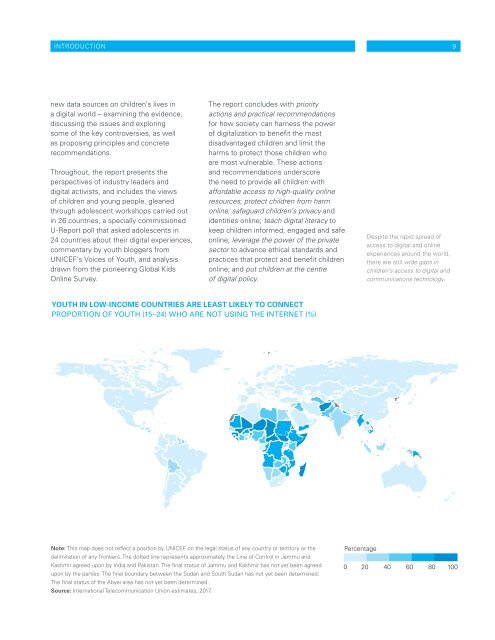SOWC_2017_Summary_En_WEB_FINAL
You also want an ePaper? Increase the reach of your titles
YUMPU automatically turns print PDFs into web optimized ePapers that Google loves.
INTRODUCTION<br />
9<br />
new data sources on children’s lives in<br />
a digital world – examining the evidence,<br />
discussing the issues and exploring<br />
some of the key controversies, as well<br />
as proposing principles and concrete<br />
recommendations.<br />
Throughout, the report presents the<br />
perspectives of industry leaders and<br />
digital activists, and includes the views<br />
of children and young people, gleaned<br />
through adolescent workshops carried out<br />
in 26 countries, a specially commissioned<br />
U-Report poll that asked adolescents in<br />
24 countries about their digital experiences,<br />
commentary by youth bloggers from<br />
UNICEF’s Voices of Youth, and analysis<br />
drawn from the pioneering Global Kids<br />
Online Survey.<br />
The report concludes with priority<br />
actions and practical recommendations<br />
for how society can harness the power<br />
of digitalization to benefit the most<br />
disadvantaged children and limit the<br />
harms to protect those children who<br />
are most vulnerable. These actions<br />
and recommendations underscore<br />
the need to provide all children with<br />
affordable access to high-quality online<br />
resources; protect children from harm<br />
online; safeguard children’s privacy and<br />
identities online; teach digital literacy to<br />
keep children informed, engaged and safe<br />
online; leverage the power of the private<br />
sector to advance ethical standards and<br />
practices that protect and benefit children<br />
online; and put children at the centre<br />
of digital policy.<br />
Despite the rapid spread of<br />
access to digital and online<br />
experiences around the world,<br />
there are still wide gaps in<br />
children’s access to digital and<br />
communications technology.<br />
YOUTH IN LOW-INCOME COUNTRIES ARE LEAST LIKELY TO CONNECT<br />
PROPORTION OF YOUTH (15–24) WHO ARE NOT USING THE INTERNET (%)<br />
Note: This map does not reflect a position by UNICEF on the legal status of any country or territory or the<br />
delimitation of any frontiers. The dotted line represents approximately the Line of Control in Jammu and<br />
Kashmir agreed upon by India and Pakistan. The final status of Jammu and Kashmir has not yet been agreed<br />
upon by the parties. The final boundary between the Sudan and South Sudan has not yet been determined.<br />
The final status of the Abyei area has not yet been determined.<br />
Source: International Telecommunication Union estimates, <strong>2017</strong>.<br />
Percentage<br />
0 20 40 60 80 100


